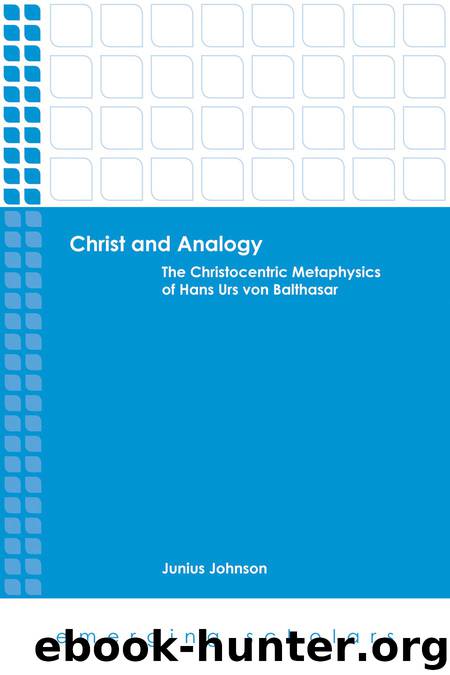Christ and Analogy by Johnson Junius

Author:Johnson, Junius [Junius Johnson]
Language: eng
Format: epub
ISBN: 978-1-4514-6523-5
Publisher: Fortress Press
Published: 2013-01-08T16:00:00+00:00
II. The Two Metaphysics of Hans Urs von Balthasar: Ideal and Historical
The path we have taken to this point, through the necessity of the concrete specificity of the Christ, entails that the historical Logos has a starting point within history, as was mentioned.[27] This in turn entails a change in the person of the Logos—before the Incarnation, the Logos is a divine person only, but after and forever more, the Logos is now a divine and human person. While this obviously does not imply any change in the divine nature, it certainly requires a change in the person who is assuming human nature in such a way as to count as a human person as well as a divine person.
This point, obvious as it may seem, is of no small importance for a system of the type von Balthasar is developing. For it is a system which takes as its first principle a person, understood neither as a placeholder for personality generally (a more modern tendency) nor as a single personal life abstracted from its particularities (which von Balthasar contends to be the Neo-Platonic tendency);[28] rather, it is a person in all the concretivity of a lived life (first divine, then divine-human). It follows that a fundamental change in the nature of that person must also entail a fundamental change in the nature of any reality founded upon that person. And the hypostatic union is by definition such a change in the person of Christ.
We have in fact seen the emergence of two different grounding reasons for the metaphysical primacy of Christ: (1) On the one hand, Christ’s primacy has been grounded through the order of creation. This line of thinking, that which began with Augustine and found fulfillment in Bonaventure’s exemplarity, proceeded from the notion of Christ as image within the Trinity, and thus as the image on which all created images are based. The resulting metaphysics of the created order will be controlled by the dynamics of the divinity of Christ and his place within the Trinity, and as such defines the realm of possible and actual relationships between the created world based on him and the trinitarian world he represents. (2) On the other hand, Christ’s primacy was also grounded in the historical problem of human salvation, in the necessity of a God-human who alone could solve the paradox of a historical existence which is nevertheless universally conditioned: from above by the archetypal divine reality, but also from within, by the fact of original sin and the universal human need for salvation. The metaphysics that follow upon this must think the center as a divine-human reality, as an analogy which is no longer able to be thought in classical Platonic terms as a downward conditioning reality, but which must now be taken to be the dynamics of concrete existence in the union of the uncreated and created worlds (a union that nevertheless remains controlled from above).
It is therefore necessary to speak not of one but of two
Download
This site does not store any files on its server. We only index and link to content provided by other sites. Please contact the content providers to delete copyright contents if any and email us, we'll remove relevant links or contents immediately.
Signature in the Cell: DNA and the Evidence for Intelligent Design by Stephen C. Meyer(2879)
Real Sex by Lauren F. Winner(2873)
The Holy Spirit by Billy Graham(2782)
The Secret Power of Speaking God's Word by Joyce Meyer(2760)
The Gnostic Gospels by Pagels Elaine(2403)
Jesus by Paul Johnson(2232)
Devil, The by Almond Philip C(2207)
23:27 by H. L. Roberts(2144)
The Nativity by Geza Vermes(2120)
Chosen by God by R. C. Sproul(2058)
All Things New by John Eldredge(2052)
Angels of God: The Bible, the Church and the Heavenly Hosts by Mike Aquilina(1871)
Angels by Billy Graham(1846)
The Return of the Gods by Erich von Daniken(1843)
Knowing God by J.I. Packer(1727)
Jesus of Nazareth by Joseph Ratzinger(1710)
Evidence of the Afterlife by Jeffrey Long(1707)
The Gnostic Gospel of St. Thomas by Tau Malachi(1682)
How To Be Born Again by Billy Graham(1673)
